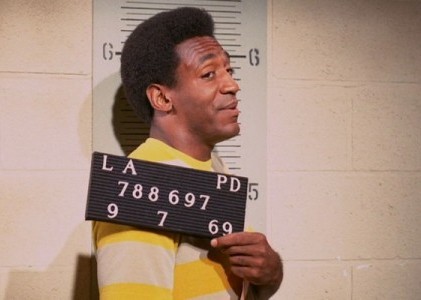Nobody's Fool
Bill Cosby contains multitudes, televisually speaking, but he usually plays a variation on the same guy. From I Spy's wise-ass intelligence agent (his debut) to the ultra-cool older-brother surrogate dishing out life lessons between Fat Albert cartoons to "America's dad" on The Cosby Show, his TV presence has spanned generations while retaining a soothing, minor-key-curmudgeon vibe that's all his. Even his present-day role as conservative scold is arguably more crotchety grandpa than incisive social critic.
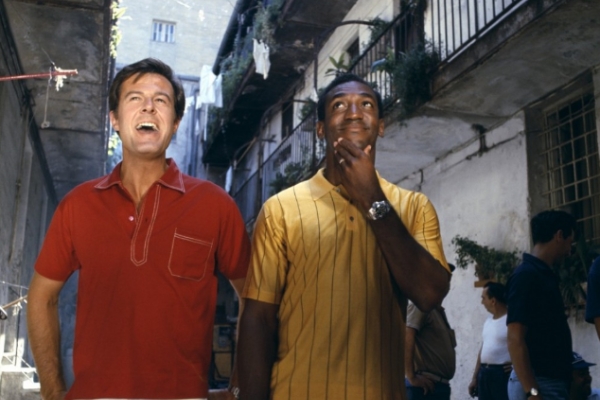
Robert Culp and Bill Cosby in the television series I Spy
Cosby's sophomore TV persona, however, in his first solo series, is both his least-seen and most ostensibly un-Cosby-like. For two short seasons from 1969 to 1971, NBC's The Bill Cosby Show allowed its star/producer to boldly experiment with the medium that made him a household name, while also discreetly settling some long-standing scores with how it perceived and portrayed African-Americans. The show reveals a level of daring and artistry that might surprise even Cosby's most loyal admirers, and refutes his reputation with apostates as a harmless funnyman or worse.
Cosby's more benign incarnations are the ones that loom largest in American television history, and they're typically the focus whenever he's feted by media institutions. The list of those accolades is long, but among them are his recognition at the Kennedy Center Honors in 1998, the Museum of the Moving Image's own in-person "An Evening With Bill Cosby" from last February, and most recently the Paley Center's ongoing "Hey, Hey, Hey ... It's Bill Cosby," which is screening some of his rarer TV appearances.
But while these events inevitably mention The Bill Cosby Show in some fashion, few people seem to have seen more than an episode or two, if that. Typically, as with Neil Genzlinger's New York Times piece on the Paley Center program, it's the mid-first-season entry "The Elevator Doesn't Stop Here Anymore," and that's largely because it features Henry Fonda in a rare TV guest spot. More often, the series is summed up along the lines of the Moving Image program notes from last year, which call it "the first sitcom to provide a genuine portrayal of middle-class life for African-Americans."
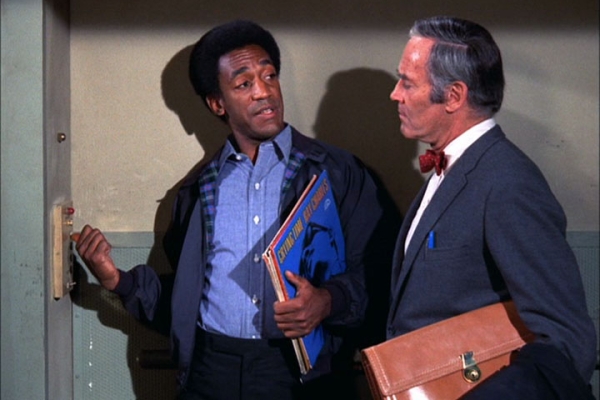
Bill Cosby and Henry Fonda in the television series The Bill Cosby Show
That assessment is accurate (though considering that Cosby played a public school employee in the show, "would-be middle-class" might be closer to the truth), but it doesn't begin to suggest the ways in which The Bill Cosby Show flouts television's customary conception of black American lives, and TV series tropes in general. Its protagonist, Los Angeles high school phys-ed teacher and coach Chet Kincaid, could be laid-back, but the series was at its core rebellious, defiant, and even angry.
The show's departures from convention could fill a catalogue: Its use of Quincy Jones's funky incidental music and addictive theme song, "Hikky Burr" (in which Cosby scats incomprehensibly over an infectious groove1); slyly off-color jokes (veteran character actor Lee Weaver, who has a recurring role as Kincaid's brother, brings out the naughty school-kid in Cosby—see "Brotherly Love," in which the two share a bed); Kincaid's understated flirtation with a white, married female colleague, guidance counselor Marsha Paterson (Joyce Bulifant, also in a recurring role); and his strong but complex family relationships, played for broad comic effect but never unrealistically or unsympathetically ("Lover's Quarrel," featuring Chitlin' Circuit vets "Moms" Mabley and Mantan Moreland as Kincaid's murderously at-odds aunt and uncle, is the best example).
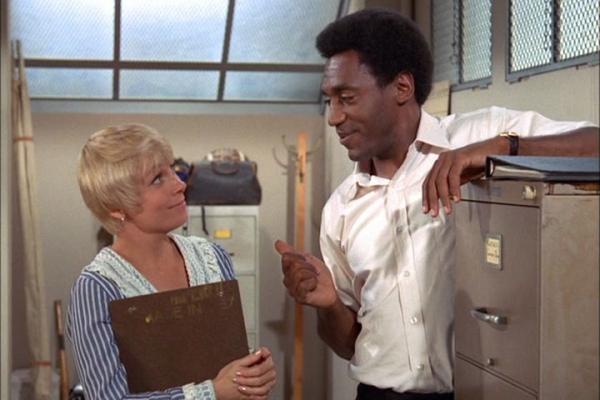
Joyce Bulifant and Bill Cosby in The Bill Cosby Show
The list goes on, and as these examples imply, the show's prolific use of underutilized black actors and production staff was something remarkable. In addition to Weaver, Mabley, and Moreland, the acting roster included Rex Ingram, Lillian Randolph, Don Pedro Colley, Roy Glenn, and Gloria Foster, among many others. Behind the camera, Ivan Dixon and Melvin Van Peebles (whose Sweet Sweetback's Baadasssss Song Cosby helped finance around the same time) directed episodes, and Cosby himself helmed a few. Long before BET, The Bill Cosby Show incorporated black people into television in a way that hadn't been done before, and not simply in a well-meaning effort to reflect "diversity" or for the benefit of white liberal viewers' (or latter-day TV critics') smug self-satisfaction. Somebody—Cosby, his co-producers (and fellow Philadelphians) Marvin Miller and Ed Weinberger, the writing and production staff, or more likely a combination thereof—took pains to flip the usual TV mise-en-scène on its head.
Most noticeably, this takes the form of a higher than average number of African-Americans in the backgrounds of any given scene. In some episodes, like the standout late-first-season entry "The Blind Date" (directed by reliably inventive TV stalwart Ralph Senensky and guest-starring Cicely Tyson), it was tough to spot a white extra at all, let alone one with a speaking part. Sometimes there was real bite to this tactic, as in "A Girl Named Punkin," when Kincaid gives art lessons to a group of poor black and Latino children in a volunteer community center; Cosby engages each of them in his gently irascible manner, until he comes to the sole white kid present and essentially dismisses him.
The set dressing also made a contribution to what academic Bishetta D. Merritt, in her essay "Bill Cosby: TV Auteur?"2 calls its "black ambiance." There are prominent photos of Martin Luther King Jr. and Thurgood Marshall in Kincaid's school office, and his apartment walls are decorated with works by African-American artist and printmaker Charles White and others. Even the sound department pitched in: in several second-season episodes, the pervasive drone of helicopters can be heard outside Kincaid's home—never as a plot point, but the racket (instantly recognizable by Angelenos as police choppers) implies that Chet lives somewhere distinctly more down-market than the bland suburban neverland that most series inhabit.
In at least one case all these components combine into inventive visual satire. A protracted scene in the school cafeteria from "Really Cool," the episode directed by Van Peebles (who displays a near-baroque disregard for traditional TV camera setups), seems innocuous enough—until you pay attention to the serving station in the foreground, and particularly to some strategically placed slices of white bread:
To be fair, Kincaid's blustery come-on at the end of the scene is similarly aligned with a ham slab on the steam table. Cosby's nothing if not egalitatarian.
Such touches sound minor if not subliminal, and they're among the more frequently discussed aspects of the show, but they're also instrumental in bolstering its unconventional depiction of a black character negotiating the white world. They're clearer in context, too. Working-class African-Americans weren't unheard of on television in 1969, even in leading or prominent supporting roles, and in that regard the series was more part of a general trend than a quantum leap forward. Then again, Chet Kincaid couldn't have been further from the black characters on contemporaneous television hits like Julia and Room 222, to say nothing of Ironside or Star Trek.
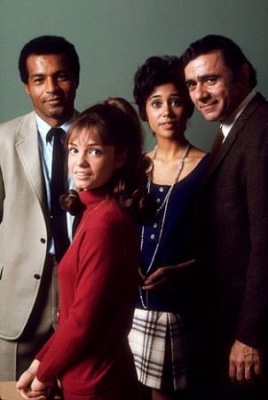
The cast of the television series Room 222
Like The Bill Cosby Show, Room 222 centers on Southern California teachers and similarly mainstreams its African-American leads by integrating them into a traditionally white setting without undue fanfare. But its color-blindness is laughably utopian in hindsight, and the series itself so rarely strays from the confines of the crusading-educator genre (popularized in movies like To Sir, With Love and Up the Down Staircase) that it becomes formulaic in a matter of a few episodes. On the flip side, Julia, about a single-mom nurse struggling to raise her son alone, coasts on its protagonist's blackness even as it glamorizes it (partly by featuring a glamorous lead actress, Diahann Carroll), dodging all but the most platitudinous references to race and gender along the way3. Worse, it pairs its star with a white leading man (avuncular television fixture Lloyd Nolan), no doubt to help the medicine go down easier for white audiences. Both shows were undeniably products of their time, but their reliance on the notion of racial advancement through hard work smacks of an assimilative ethos that was beyond stale even—or especially—in 1969.
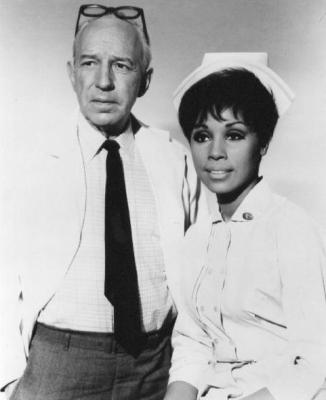
Lloyd Nolan and Diahann Carroll in the television series Julia
By contrast, whenever Chet Kincaid is shown doing the actual work of teaching or coaching, he's fallible and exasperated ("Lover's Quarrel"), or just plain out of his depth ("Let X Equal a Lousy Weekend," a brilliantly realized math-hater's nightmare). His private life—dating, dealing with neighbors and family—doesn't run much more smoothly (more on that later), but his work experience typically requires him to find creative ways around an entrenched bureaucracy ("Rules Is Rules," "Growing Growing Grown," "Teacher of the Year"). And more often than not it brings out the crafty dissembler in him.
Grappling with conditions of chronic, unworkable disrepair is, in many ways, The Bill Cosby Show's primary subtext; even in the representative episode Genzlinger and others glom onto, a school elevator stalls and traps Kincaid inside overnight with an English teacher (Fonda) and a non-English-speaking cleaning woman (Elsa Lanchester). This being a Bill Cosby joint the night ends with some valuable lessons learned, but such frustrations make up Kincaid's daily life both in and out of work so exclusively as to be glaring. Although these may well play to Cosby's conservatism (and doesn't exactly represent cutting-edge sitcom material), an African-American working man reacting to systemic breakdown with impatience, impudent sarcasm, and finally self-sufficient ingenuity is an easy form of rebellion to overlook. The Civil Rights Act was barely five years old, after all, and television is consistently at least that far behind the times.
Merritt claims that "Chet contradicted [a] black image of that period—the riotous rebellious black," and while it's true that The Bill Cosby Show is never truculent or openly political, it's also anything but retiring or capitulatory (insofar as any network series can sidestep capitulation altogether). Its inverted social palette—which must have ruffled the feathers of the same Deep South NBC affiliates who'd initially refused to broadcast I Spy due to Cosby's presence—registers real outrage with the status quo and gives the distinct impression that some form of justice is being broached if not served, subtly but with real force.
Did Cosby's NBC bosses (and the show's sponsors, Procter & Gamble) understand what Cosby was up to and condone it, or hate it and keep mum for fear of losing him to another network? Or were they just oblivious to the contained insurrection in this series they saw fit to plant smack in the middle of the Sunday-evening family hour? It's hard to say, but The Bill Cosby Show was cancelled after its second season on the grounds of low ratings. It never went into syndication or later rotation on the cable nostalgia channels, ensuring that its quiet radicalism has gone virtually unnoticed ever since; even a pair of DVD releases from Shout! Factory in 2006 (Season 1) and 2010 (Season 2) did little to generate attention or thoughtful criticism.4
Then again, scarcity may be only half the problem. The Bill Cosby Show is at least as narratively challenging as it is visually and socially cunning, and getting into its singular groove takes real patience. Chet Kincaid resists easy audience identification by design, and this could be The Bill Cosby Show's bravest departure from television norms.
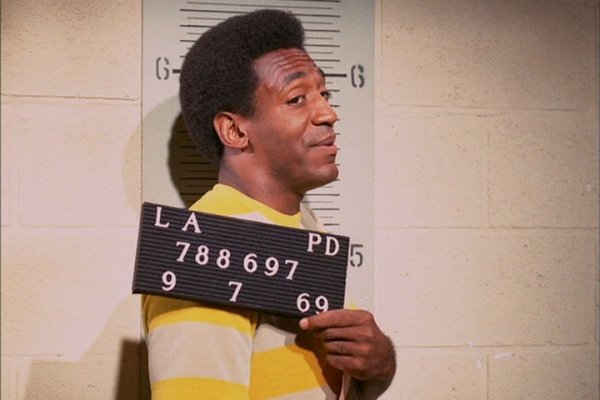
Bill Cosby in The Bill Cosby Show
Most of Cosby's celebrated personality traits are present in Kincaid, but there's a beguiling mix of looseness and determination to the character that seems fresh and transitional. In that regard The Bill Cosby Show may be at least partially a response to the actor's experience on I Spy, which tended to play too heavily to both his benevolence and incipient fuddy-duddyness. An impeccably dressed teetotaler with an advanced degree and a relentless work ethic, agent Alexander Scott—while against the grain at the time—wasn't that different from the insufferable role models on Room 222 and Julia.
I Spy obviously allowed Cosby to learn screen acting and become a bona fide television superstar in the process; he won Best Actor Emmys for all three seasons, shutting out his TV-veteran co-star Robert Culp every time. But the style and substance of The Bill Cosby Show suggests that I Spy also inhibited something in Cosby, and he liberated it with a vengeance. For one thing, not sharing this particular spotlight with a co-lead or ensemble appeared to suit him. The resolutely single Kincaid lives alone and likes it, and apart from being a prolific dater sets strict limits on social interactions of every kind (which are routinely broken, as in "The Old Man of 4-C"). For all Chet's bumbling, goofy agitation, the self-sufficiency and ease that characterize his life are resoundingly adult traits. Cosby, a longtime husband and family man by this point, seems to thrive in the role, and his enthusiasm is palpable.
More important, it freed him to more fully develop the slow-burning, often haphazardly improvisational brand of humor he and Culp had worked out in I Spy. This results in an odd, edgy rhythm that can be uncomfortable to experience, like an awkward but deliberate pause in a meandering conversation. It also leaves little room for traditional sitcom-style comedy—Cosby was adamant that the show have no laugh track, but it's hard to imagine one would have goosed the laughs much anyway, or could even have been timed effectively. Kincaid's predicaments elicit deep, satisfying chuckles, never guffaws, and the peculiarly charged calm this produces is mesmerizing, unnerving, and ultimately addictive.
Scenes play too long and frequently go nowhere, and damn if you can foresee how most episodes will achieve anything like a resolution, although they usually do. The highest-concept episode from the series's first season, "Rules Is Rules," pivots on the acquisition of an air-pump needle, while even a relatively plot-heavy two-parter from Season 2, "The Deluge," stretches astonishingly thin Kincaid's profound discomfort over having to deliver the baby of a pregnant neighbor. (Cosby the didact prevails in this entry, which gives his pet theme of doing the right thing whether you want to or not ample exercise. What's surprising is that "Deluge" also features a jaw-dropping abundance of subtly suggestive gynecological humor.) Cosby himself is arguably the only situation The Bill Cosby Show ever needed, but the way he keeps himself at a distance from the material without condescending to it is unusual and invigorating, as is the show's habit of unhurriedly constructing its modest narratives, sidling up to them obliquely, then hanging back to see how (or if) they'll play out.
In a rambling interview on Shout! Factory's first-season DVD set Cosby calls this style "Frank Capra in 22 minutes." That may be pure self-aggrandizement, and I'm not sure it's accurate or especially flattering, but the comparison holds as long as you picture Groucho Marx hijacking one of Capra's programmatic exercises in earnest Americana and good-naturedly tossing it on its ass.
The production jettisoned some of this obliquity in its second season, when the plotting became more assertive and, disappointingly, the background extras were more pointedly balanced between blacks and whites. But The Bill Cosby Show was never fully tamed, and whether it delights or bores you or is an affront to your notion of what television comedy should be, the series isn't quite like any other. Even the subsequent stains on Cosby's reputation, from accusations of sexual misconduct and his unsolicited role as black culture's moral umpire, can't erase the risks he took in the series, or the ways in which it expanded his familiar television persona: stubborn, sometimes jarringly childlike in his guilelessness and inclination to mug, subservient to no man yet engaged head-on with the world as it is, and not about to squander the privilege of landing a job he loves by doing it the way everyone else has, Bill Cosby is nobody's fool.
1. Each season has a different version: The first is reserved and deeply soulful, while the second (my favorite) is fast, chunky, and nakedly ecstatic. Neither is on Concord Records' excellent 2004 release Quincy Jones and Bill Cosby: The Original Jam Sessions 1969, but it does feature three completely different versions.
2. Journal of Popular Culture, Vol. 24, Issue 4, pp. 89-102, Spring 1991.
3. Maybe on one level such references were just irrelevant. In her 2005 book Revolution Televised: Prime Time and the Struggle for Black Power, University of California, Davis Critical Studies professor Christine Acham says of Carroll (and Good Times star Esther Rolle), "Far from simply being disempowered cogs within the television machine, both actresses ... helped in opening up the concept of the television text beyond what was on the screen." A similar argument can be made for Cosby's presence in I Spy.
4. One happy exception is a 2010 post by television historian Stephen Bowie on his Classic TV History blog. Bowie elaborates nicely on the surprisingly sexy interplay between Cosby and Bulifant. ![]()
LATEST ARTICLES
-20140814-173707-thumb3.jpg)
Fighting Words
by Imogen Sara Smith
posted August 12, 2014

Fighting Words, Part 2
by Imogen Sara Smith
posted August 20, 2014

On the Margins: The Fil…
by Andrew Chan
posted August 12, 2014

Robin Williams: A Sense…
by David Schwartz
posted August 12, 2014
 Nobody's Fool
Nobody's Fool
 The Bill Cosby Show
The Bill Cosby Show
THE AUTHOR
Mark Holcomb is a contributor to Time Out New York, and has written for The Village Voice, Film Quarterly, and other publications. He lives in Brooklyn, New York.
More articles by Mark Holcomb
